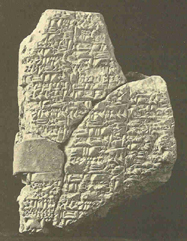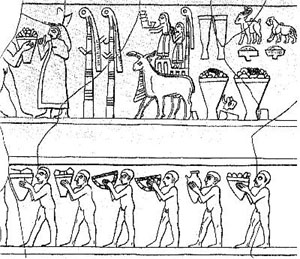Religious and Cultural Influences on Technological
Development in Ancient Sumeria
Stacey L. Prow
Image from an ancient Sumerian cylindical seal. The pattern on the seal leaves a positive impression when rolled over wet clay (URL: http://faculty.evansville.edu/rl29/art105/img/sumer_seal.jpg).
Ancient Mesopotamian technologies can be tenuously traced through the assorted cultures and civilizations that inhabited the region between the Tigris and Euphrates rivers: Sumerians, Hittites, Assyrians, Arabs, and others. I say “tenuously” not due to a lack of scholarly evidence, but rather due to the nature of the cultures themselves. Although many original technologies remained part of the conquering culture, these technologies rarely remained stagnant. As old cultures gave rise to new, so do old technologies spur new inventions. It has become difficult to trace the origins of Mesopotamian technologies because technology has evolved in an almost continuous stream among these civilizations as if they were one coherent society.
Most ancient Mesopotamian technologies1. can be traced back to the Sumerians. Ancient Sumeria, located along the historical banks of the Persian Gulf in the Near East, encompassed an aggregation of city-states. The first urban centers arose in southern Mesopotamia during the 4th millennium B.C.E from many smaller, self-sufficient tribes2. During different “kingdoms,”different city-states held the seat of power in the ancient Sumeria. Most frequently mentioned in the literature are Kish, Ur, and, Uruk. Sumerian culture, like many other “primitive” cultures, placed a lot of emphasis on religious deities, often in the image of nature or natural forces. The Sumerians inhabited various city-states, each centered around a temple called a ziggurat. Each city-state had a separate god; however, interactions between communities fostered the development of elaborate mythologies detailing the interactions between local gods.
Among the local gods, fixed hierarchical structures developed. These complex schemes of hierarchy translated into a highly stratified social scheme as well. Early Sumerian law recognizes these class distinctions. The Sumerians developed highly organized systems of weights and measures, currency (using their silver technology), and writing to keep record of all the comings and goings of property and people within a city-state. Much of the early mathematics of Sumeria was developed for record keeping purposes. For instance, cuneiform tablets using mathematical tables for land measurement (2600 B.C.E.) and tabular accounts of domesticated animals from the archives of Ur (2028 B.C.E.) are among the earliest records of mathematics.
The development of Cuneiform writing in Sumeria most likely developed as a means of recording, although there still remains controversy in the field. Early cuneiform in Sumeria dates to 3400 B.C.E, almost a century before pictograms developed in Egypt, although the exact origin of written language is veiled. In the early third millennium B.C. this writing system, largely ideographic, was developed for practical reasons such as recording receipts and expenditures. By about 2500 B.C. a number of other types of text developed – literary, mythological, mathematical and astronomical, and educational. It is in these clay tablets of daily life that much of Sumerian culture has come to light. The Babylonians and Assyrians adapted cuneiform for their own Semitic languages and spread its use to neighboring countries.
The importance of religion in daily life likely contributed to many early Sumerian technologies. Weaved into a mythology of Sumerian gods, detailed astronomical charts that mapped celestial positions were developed. It was based on celestial orbits that a number system was developed representing measures of a circle. Religion also most likely indirectly spurred the development of clay and metal working technologies. Most art from this period served a functional use and, many times, a religious significance as well. Examples of Sumerian technology include chisels and hammers for working with elaborate jewelry and clay items, such as statues of gods.
Sumerians were also adept at silver working, using silver with comparable purity to modern sterling silver. Although early jewelry and other metal artifacts may have been developed for religious reasons, metallurgy quickly developed to include a much wider range of objects. Early silver jewelry from the Royal Tombs of Ur (dated to about 2500 B.C.E) met specifications recorded in cuneiform tablets from the third millennium B.C.E. The artifacts predate most information about metallurgy recovered from cuneiform texts, indicating that silver-working technology may have developed much earlier. Archaeologists have uncovered early animal artifacts at Uruk that were crafted from different materials including bronze, gold, limestone, and lazuli, showing the extent to which Sumerians were adepts at manipulating metallurgical technology.
Religion, however, seems to be noticeably absent from early medicinal technologies. Although later incorporated into Babylonian and Assyrian medicine, magic and religion was not part of the earliest records of Sumerian medicine. The earliest known medical text, a tablet from 2100 B.C.E., is “completely rational,” according to Martin Levey, wholly concerned with the compounding of drugs from botanical, zoological, or mineralogical sources. The Sumerians also significantly advanced alchemy and early chemistry. Early Mesopotamian cultures are credited, as C. J. Singer puts it, with creating “the earliest chemical industry.” A variety of chemical compound (including, alum, gypsum, sodium chloride, and sodium chloride) were used in combination with other natural materials for medical treatment, .
Although Sumer gradually, or in some cases abruptly, gave way to new cultures, it’s ancient technologies have lived on in many forms through the Babylonians and, later, the Assyrians. Sumerians were a highly technological society that developed many advances used in later cultures. These technologies were not created in a sterile environment. Sumerian technology is permeated by the cultural context in which it was created. Just as early Sumerian technologies were further developed in the cultural context of later civilizations. Technological history has typically fallen under the prevue of either historians who have limited understanding of science or scientists that have little grasp of cultural context. Analysis of ancient technology will greatly benefit by intermixing lingual, scientific, historical, religious, and cultural schools of thought.


(Left) Cuneiform tablet from ancient Sumeria. Original picture from the University of Pennsylvania Department of Eastern Languages and Civilizations (url: www.sas.upenn.edu/nelc/links.htmnear). (Right) Pencil drawing of impression of a temple vase from Warka (also known as Eruk), dating from approximately 3100 BCE (URL:www.cartage.org.lb/.../SumerianSculpture.htm).
References
Technology is used in the broadest sense of the term to mean technological advances including, but not limited to, advances in food production and animal domestication, which is not directly addressed in this paper; medicine; writing and accoutrements that typically accompany the development of language (such as printing, paper, texts); general scientific knowledge (mainly astronomy and mathematics); architecture; irrigation, and metallurgy.
Pittman, Holly. Ancient Near Eastern Art. Recent Acquisitions, No. 1986/1987. The Metropolitan Museum of Art: 1986-1987.
Westenholz, Aage. Early Nippur Year Dates and the Sumerian King List. Journal of Cuneiform Studies, Vol. 26, No. 3. 1974: 154-156.
Kings often reigned for thousands of years, according to cuneiform texts. Many achievements of later periods are placed in the historical context of one of the great kings. Archaeologists believe that the list refers to the great kings, as evidence of burial rites for other local kings has been found.
Uruk is also called ancient Warka. Uruk is referred to as Erech in the Bible (Pittman, 1987).
Book Review: Sachs, Abraham. Sumerian Mythology: A Study of Spiritual and Literary Achievement in the Third Millennium B. C. by S. N. Kramer. The Journal of Religion, Vol. 25, No. 3. 1945: 222-223.
Sumerian mythology is compiled around 17 stories of gods and heroes, according to S.N. Kramer (Sachs, 1945).
Sumerians are credited with the first advent of law. Most scholars agree that the Code of Hammurabi (written by the Babylonians) is a representation of older Sumerian laws. Recently the Laws of Eshnunna were discovered in ancient cuneiform, several hundred years older than the Code of Hammurabi. Information from a book review: Finegan, Jack. The Laws of Eshnunna by Albrecht Goetze. Journal of Bible and Religion, Vol. 25, No. 1. 1957: 87-88.
Segrè, Angelo. Babylonian, Assyrian and Persian Measures. Journal of the American Oriental Society, Vol. 64, No. 2. 1944: 73-81.
Book Review: Kidwell, Peggy. A history of Mathematical Tables: From Sumer to Spreadsheets edited by Martin Campbell-Kelly et al. Technology and Culture, Vol. 45. 2004: 662-664.
Book review: Dalley, Stephanie. The Invention of Cuneiform: Writing in Sumer by Jean-Jacques Glassner. Technology and Culture, Vol. 46. 2005: 408-9.
Johnston, Christopher. The Sumero-Akkadian Question. Journal of the American Oriental Society, Vol. 15. 1893: 317-322.
Book review: Biggs, Robert. The Sumerians: Their History, Culture, and Character by Samuel Noah Kramer. Technology and Culture, Vol. 5, No. 3. 1964: 445-446.
Johnston, Christopher. The Sumero-Akkadian Question. Journal of the American Oriental Society, Vol. 15. 1893: 317-322.
Sarton, George. Chaldaean Astronomy of the Last Three Centuries B. C. Journal of the American Oriental Society, Vol. 75, No. 3. 1955: 166-173.
Dimand, Maurice. A Sumerian Sculpture of the Third Millennium B.C.The Metropolitan Museum of Art Bulletin, New Series, Vol. 3, No. 10. 1945: 253-256.
Ancient Sumerians were able to refine silver to 92.5% pure, the equivalent of modern sterling silver. This information is from: Mellichamp, J. and Martin Levey. Silver from Ur of Ancient Mesopotamia. Science, New Series, Vol. 142, No. 3588. 1963: 44-45.
The city-state structure, although generally rules by a great king, led to interstate warring to vie for power. This conflict led to the development of metallurgy as a technique for making tools of war. The picture of the Sumerian dagger at the bottom of the page is an embellished example.
Mellichamp, J. and Martin Levey. Silver from Ur of Ancient Mesopotamia. Science, New Series, Vol. 142, No. 3588. 1963: 44-45.
Pittman, Holly. Ancient Near Eastern Art. Recent Acquisitions, No. 1986/1987. The Metropolitan Museum of Art: 1986-1987.
Leicester, Henry. Chemistry and Chemical Technology in Ancient Mesopotamia by Martin Levey. Isis, Vol. 51, No. 4. 1960: 587-588.
Levey, Martin. Gypsum, Salt and Soda in Ancient Mesopotamian Chemical Technology by Martin Levey. Isis, Vol. 49, No. 3, 1958: 336-342.
Quoted from a secondary source: Levey, Martin. Alum in ancient Mesopotamian technology. Isis, Vol. 49, No. 2. 1958: 166-69. Primary source: Singer, C.J. The earliest chemical industry. (London: Folio Society, 1948).
Levey, Martin. Gypsum, Salt, and Soda in Ancient Mesopotamian Chemical Technology. Isis, Vol. 49, No. 3. 1958: 336-342.
Many of these chemical compounds have uses in other areas of technology. Alum, for instance, was employed in tanning, dyeing, glass-making, and washing.
Sumerian dagger, unearthed in present-day Iraq, from 2600 B.C.E. (URL: http://iraqprofile.blogspot.com/2005/02/artifacts-iraqmesopotamia-from-3000-bc.html).
Send message to Swarthmore College Environmental Studies
last updated 3/02/06
webmaster